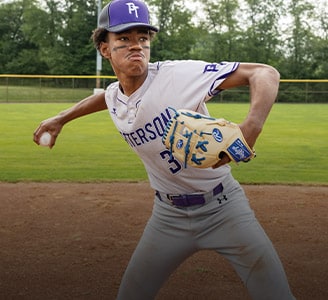Hitting All Parts of the Zone with Amanda Chiddy Chidester
Command complete coverage and leave no holes in your softball swing with these tips from the softball pro.

Not every pitch is going to be right down the middle. Pitchers will try everything in their arsenal to beat you at the plate. High pitches. Low pitches. Breaking pitches. Anything to try and fool you into mishitting a ball or missing completely. To combat their efforts, it’s important to be able to hit pitches in all parts of the strike zone.
Professional softball player Amanda Chidester has a few hitting drills to help you leave no corner uncovered with your swing. Learn how you can train to hit all parts of the zone with these Pro Tips.
WHY COMPLETE COVERAGE IS IMPORTANT
Being able to hit all parts of the zone should be a desirable skill for batters.
“I take pride in being able to hit all parts of the zone,” Chidester says.
If you’re confident with any pitch, you can prove to be a bigger offensive asset to your team. Additionally, if you are unlimited in your hitting strengths, you can be harder to get out. Opposing pitchers and defenses love to take advantage of a batter’s weaknesses. Taking command of the strike zone can be a huge advantage in your favor with every plate appearance.
SOFTBALL HITTING DRILLS FOR INSIDE PITCHES
Getting accustomed to hitting an inside pitch takes practice. To prevent the pitch from running in on you, you should meet the ball out in front with quick hands. According to Chidester, you should start with basic tee work to learn how to hit an inside pitch.
Set up your batting tee on the front inside corner of the plate. Feel free to adjust the height of your tee to your liking. Focus on the ball and take a strong, direct swing. Aim for solid contact that results in a line drive.
“I want to make sure that I get the ball to the back of the cage if I’m hitting in cages, or if I’m on the field, hitting it up the middle,” Chidester says. “My goal as a hitter is always to hit the ball up the middle.”
After taking your reps on the batting tee, Chidester says to move on to front toss. This softball hitting drill can help simulate incoming pitches as you track the ball in. Have your coach or partner set the net close enough so they’re able to repeatedly snap pitches into the zone. A good distance to aim for should be around 15 feet. To simulate inside pitches, angle the front toss net so your front tosser is throwing inward toward your hands. For right-handed batters, the front toss net should be angled to your right and down the first base line. For left-handed batters, the front toss net should set angled to your left and down the third base line.
Angling your front toss to simulate inside pitches can help force you to meet the ball out in front. If you wait too long, the ball will run into your hands, resulting in a contact error or a swing-and-miss.
“So, as a hitter, I have to make sure that I really am quick to get that barrel on the inside half of that ball to be able to successfully hit it up the middle,” Chidester says.
SOFTBALL HITTING DRILLS FOR OUTSIDE PITCHES
As with inside pitches, Chidester says to begin with tee work when working on how to hit an outside pitch. However, rather than having the tee out in front, place your batting tee on the back outer half of the plate. A good reference point should be your belly button or belt buckle. This can help simulate your preferred contact point as you let the ball come into your zone. Meeting the ball deeper in the zone can help ensure you hit with the sweet spot of your bat. You can also better recognize breaking pitches that tend to tail farther away from batters.
With each swing, you should continue to strive for line drive hits. Look to drive the ball up the middle or toward opposite field. To help you remember your opposite field hitting lanes, Chidester notes a simple thought process. “Thinking of it as shortstop over for a [right-hander] for opposite field and as a [left-hander], opposite field is second base over,” she says. “And that really allows us to be able to barrel up that ball without slicing it over too far to the opposite field side.”
Once your tee work is complete, you can then move into your front toss session. For outside pitches, angle your front toss net so your tosser is throwing outward. For right-handers, the net should be to your left. For left-handers, the net should be to your right. “What that helps with is when a pitcher throws a curveball, the ball breaks further away from the plate. So, if I put an angle on that front toss, it simulates it close enough for me to practice that,” Chidester says.
Work through your front toss session for a handful of reps before moving on with your training.
SOFTBALL HITTING DRILLS FOR LOW PITCHES
Low pitches in softball can force batters into inefficient body positioning. Without the proper practice, hitters can tend to top the ball, rolling it over into an easily fielded ground ball. Chidester recommends the same tee and front toss workout combo to help train the proper techniques.
To begin, set your tee so the ball sits at the lowest part of your strike zone. According to Chidester, you want low pitches to travel in more for better contact, similar to outside pitches. Have your tee placed back in the zone to create the desired point of contact. You should be able to comfortably get behind the ball for a strong swing.
Because of the deeper contact, you should strive for line drive hits either up the middle or toward opposite field. “A term that I learned when I was in professional ball was, 'Lows got to go,’” Chidester says. This term refers to, “Letting that ball travel and really hitting that ball opposite field like we talked about earlier instead of getting in front of the ball and rolling it over to the shortstop every single time.”
After your tee work, Chidester suggests moving on to front toss. For low pitches, have your tosser throw from a kneeling position, delivering the ball at a downward angle. “So, what that makes it look like is it simulates a drop ball,” Chidester says. “So, it’s coming down and we have to be able to drop that barrel head to be able to hit it up the middle instead of rolling right over the ball every single time.”
SOFTBALL HITTING DRILLS FOR HIGH PITCHES
When swinging at high pitches, it’s important to meet the ball with the right bat angle. It can be easy to get too underneath the pitch, resulting in a pop fly, according to Chidester. Instead, try to get on top of the pitch to drive it up the middle.
To work on hitting high pitches, begin with tee work. Have your tee at the highest point of your strike zone and work on developing your contact point. Get accustomed to getting on top of the ball, trying to reach the back of the cage or outfield with each hit.
You can round out your high pitch training with front toss. For this softball workout, have your partner toss each ball toward the top of your strike zone. Continue to track the ball in and get on top of the pitch for a better offensive result. “A lot of times with the high pitch, we get underneath it and then we pop it up, or we swing level and we miss the ball,” Chidester says. Stay diligent in your training and fine-tune your coverage for well-rounded success.
IT ALL STARTS IN THE HANDS
No matter the pitch location, it’s important to remember that every successful swing begins with the right batting stance. Chidester says you should begin each swing from a comfortable position where you’re ready to attack the ball.
“You really want your hands by your back shoulder so that [you] can hit a high pitch, [you] can hit a low pitch. [You] can hit an inside pitch and [you] can hit an outside pitch,” she adds. Being ready from the start can eliminate the possibility of a pitcher catching you off guard.
Hitting all parts of the zone can be a great addition to your batting skill set. With these softball training Pro Tips, you can cover all corners and approach the plate ready to drive the ball.
You’re ready to command the plate, but is your mind ready to dig in? Use these Pro Tips from Amanda “Chiddy” Chidester and discover how to boost your mental toughness in softball.






